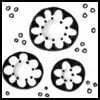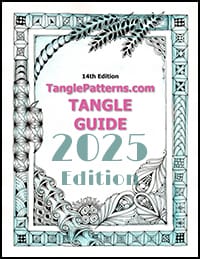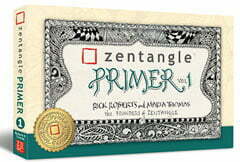 Congratulations to the CZT30 certification graduating class! Another fine group of Zentangle® enthusiasts can venture forth around the world to share the Zentangle love …
Congratulations to the CZT30 certification graduating class! Another fine group of Zentangle® enthusiasts can venture forth around the world to share the Zentangle love …
Texas CZT Sandy Hunter’s sweet Papermint tangle is the subject of our explorations today.
Sandy writes that she discovered Papermint …
while I tagged along with various members of my family to Chuck E Cheese.
I did, I’m sure, what most normal people do… pretended I was tangling on the beach with a mai tai and not surrounded on all sides by a riot of screaming children. ;o)
Zentangle is so great for that… temporary mental relocation for the cost of a pen and a tile!
Papermint is an absorbing tangle to draw, and as Sandy notes “it is not a fast pattern to draw“. It starts with orbs of various sizes which are then subdivided into sections around the edges. Varying the number of strokes around the circumference of each orb gives a different end result as you can see in my example where I used 6, 8 and 10. Those little strokes are then connected with a “swoop” and I really enjoyed that part of the Papermint construction.
A touch of shading in the centers gives dimension to Papermint, “A little shading adds some oomph… do you see innies or outies?” I see tasty Papermints!
Sandy illustrates the step-by-step instructions for drawing Papermint here on her blog and she gives lots of detailed tips to guide you with some lovely examples to inspire your Papermint efforts.
Sandy’s post also includes a Zentangle tile featuring Papermint together with Zentangle’s dewdrop tangle-enhancer, and a link to CZT Lynn Mead’s Dew Drop tutorial. (You can also find this tutorial link on the ZENTANGLE TERMINOLOGY page.) Dewdrop is one of six Zentangle enhancers which include auras, perfs, rounding, shading and sparkle.
As you enjoy any of the tangles on the site, please leave a comment of thanks and encouragement to show the artists you appreciate them for sharing their creativity to inspire yours. Your comment helps motivate them to continue to share!
Check out the tag sandyh for more of Sandy’s tangles on TanglePatterns.com.
.oOo.
Share your tangle on TanglePatterns
Everyone is invited to share patterns on TanglePatterns.com, you do NOT need to be a CZT. In order for patterns to be considered for publication they must be submitted to me by email. In other words you have to let me know about them.
For a submission to qualify as a tangle it must be a genuine pattern (“a regularly repeated arrangement, especially a design made from repeated lines, shapes, or colours on a surface”) and not the repetition of “a thing to draw”.
From The Book of Zentangle:
“Keep it Non-representational. Zentangle artwork is intended to be non-representational. Zentangle’s elemental strokes are also non-representational.
We don’t teach complex elements such as hearts, stars or flowers. Tangles are also non-representational.”
Remember that tangles never start with pencil planning.
"A tangle has no pre-planning with pencil guidelines, grids or dots, no erased lines."
If you need a refresher on what makes a tangle, read the A PATTERN IS NOT ALWAYS A TANGLE page on the ZENTANGLES menu bar at the top of any page.
For details on how to submit your pattern for consideration visit the SUBMIT YOUR PATTERN page on the top menu bar of any page on the site. On that menu you will find these two pages:
The first page includes instructions on how to prepare and send your JPGs. (Please save me time and do not send PDFs.) It also includes a link to this PDF submission form.
When your examples include additional tangles from the site, please list them in your email. (This saves me time and my memory some wear and tear.)
If your pattern is posted on your blog, attach your steps and tile JPGs to your email and be sure your email includes the direct URL so I can link to it.
And remember, to quote Zentangle's co-founders Rick and Maria: tangles should be "magical, simple and easy to create", non-objective patterns of repetitive strokes that are easy to teach and offer a high degree of success to tanglers of all ages.
"Keep the tangles as little like 'drawing something' as possible."
.oOo.
|
.oOo. |
|
Enhance your Zentangle experience while supporting TanglePatterns: |
|
CURRENT EDITION! TanglePatterns.com TANGLE GUIDE, 2025 Edition |
|
 |
The 14th Edition of the TanglePatterns.com TANGLE GUIDE is an instant-download 117-page interactive digital eBook/PDF containing over 2,000 tangles on the site from May 2010 through December 31, 2024. It's a great resource and a must-have digital tool for using the site. Visit the STORE > E-BOOKS page and help keep TanglePatterns.com going by getting your copy now! |
|
"Linda, Thank you! I was relying on too few and getting stuck after 3 years of daily working with Zentangle. This has inspired me to ‘begin again’ with renewed excitement." ~ Barbara R. |
|
| See the BOOK REVIEWS page for more details on its features and view a sample page. Note: this is a digital product you download immediately when you place your order, nothing will be physically mailed to you. | |
| If you're new to Zentangle® and tangling, my TanglePatterns.com BEGINNER'S GUIDE TO ZENTANGLE is just what you need to get started. Also available en Français and en Español. | |
|
|
|
 |
This is the only Zentangle book you'll ever need: the fabulous Zentangle PRIMER Vol 1. It's your CZT-in-a-book by the founders of Zentangle®. Visit the STORE tab on the top menu bar or click on the image. For more about the content and to read the rave reviews, visit the BOOK REVIEWS tab. |
| Now available in KINDLE format for $9.99. Spanish Edition here. Japanese Edition here. | |
| "Absolutely the best Zentangle Book yet! As an accomplished artist I used to think I did not need instruction on this art form. How wrong I was! My tangling improved by leaps and bounds after reading this book. If you think you have Zentangle down then you need this book more than ever!" ~ Kris H | |
|
|
|
|
.oOo. |
|








This is simple elegance. Thank you, Sandy.
Could you please tell me the process you follow to subdivide a circle into 10 equal parts. Thank you.
Good question as I did my example a while ago. Let’s see if I can remember …
I’m reasonably sure what I did was use that old way we learned of drawing a 5-pointed star but just “air drawing” and putting dots/points around the circumference. Then added another point/dot between each = 10. Then used those dots as the starting points for the strokes in Step 2.
Make sense?
I just love papermint. Uniformity and consistency of strokes are not needed, just relax and go for it. I could do it all day long. Thanks to Sandy Hunter!
Such a cutie! I think it asks for a zengem 😉
Thank you Sandy and Linda for sharing!